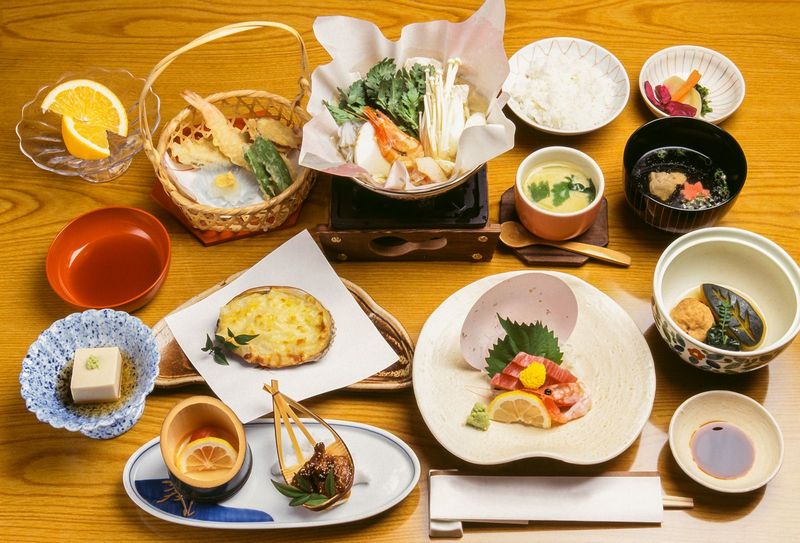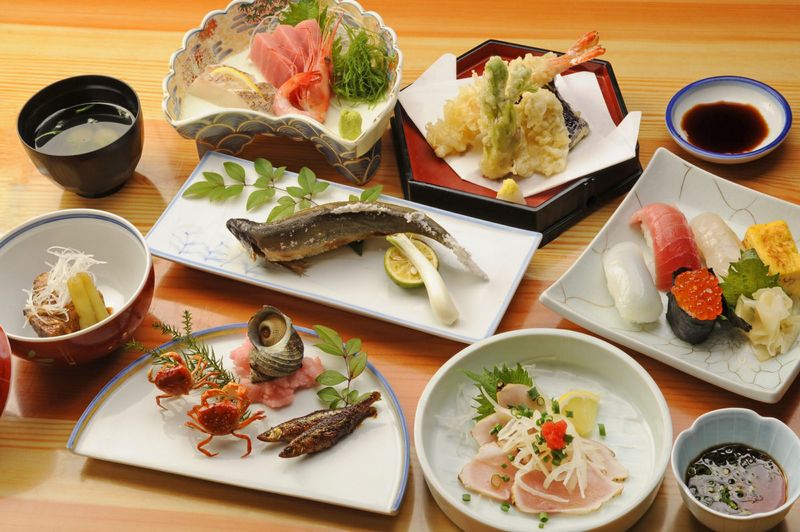
Exploring Japanese Cuisine: A Delicious Journey Through the Flavors of Japan
Embark on a culinary adventure through the vibrant and diverse world of Japanese cuisine. From the delicate art of sushi rolls and sashimi to the bold flavors of ramen and yakitori, Japanese food offers a tantalizing array of tastes and textures that are sure to delight any palate. Whether you’re a seafood lover or a fan of vegetarian dishes, Japan’s food guide has something to offer for everyone.
No journey through Japanese cuisine would be complete without indulging in the iconic dishes that have become synonymous with the country’s food culture. Start your culinary exploration with a bowl of miso soup, a traditional Japanese soup made with fermented soybean paste. The umami-rich flavors of miso, combined with the warmth of the broth and the addition of tofu and seaweed, create a comforting and nourishing dish that is enjoyed throughout Japan.
For those seeking a taste of Japan’s famous seafood, look no further than sushi and sashimi. Sushi, a dish of vinegared rice topped with various ingredients, such as raw fish or vegetables, is a staple of Japanese cuisine. Sashimi, on the other hand, is thinly sliced raw fish or seafood served without rice. Both dishes are typically accompanied by soy sauce and wasabi, a pungent green paste that adds a spicy kick to the flavors. The combination of fresh seafood, delicate rice, and the subtle tang of soy sauce creates a harmonious symphony of flavors that is truly unforgettable.
If you’re in the mood for something grilled, try yakitori, a popular Japanese dish consisting of skewered and grilled chicken. The tender and juicy pieces of chicken are seasoned with a savory soy-based marinade and cooked over an open flame, resulting in a smoky and delicious flavor. Another must-try is teppanyaki, a style of Japanese cuisine where ingredients are cooked on a flat iron griddle right in front of you. This interactive dining experience not only provides a feast for the senses but also allows you to witness the skill and precision of the teppanyaki chef as they create a mouth-watering meal.
To complete your culinary journey, don’t forget to sample some sake, a traditional Japanese rice wine. Sake is enjoyed throughout Japan and is often served alongside meals to enhance the flavors of the food. With its subtle sweetness and smooth finish, sake is the perfect accompaniment to any Japanese dish.
As you explore the world of Japanese cuisine, it’s important to familiarize yourself with Japanese dining etiquette. In Japan, it is customary to say “itadakimasu” before a meal, which is a way of expressing gratitude for the food. It is also polite to use chopsticks when eating, and to never pass food from chopstick to chopstick, as this is considered bad luck. Take your time to savor each bite and appreciate the skill and craftsmanship that goes into creating each dish.
So, whether you’re a seasoned foodie or a curious culinary adventurer, a journey through Japanese cuisine is sure to delight your taste buds and open your eyes to the wonders of oriental cuisine. From the crispy tempura to the rich and flavorful ramen, the diverse flavors and textures of Japanese food are a testament to the country’s rich culinary heritage.
The Origins of Japanese Cuisine
Japanese cuisine is a treasure trove for any foodie looking to explore the diverse flavors of oriental cuisine. With its rich history and unique dining etiquette, Japanese food offers a culinary experience like no other.
Japan, an island nation surrounded by the sea, has a strong affinity for seafood. This is evident in its most famous dish, sushi. Sushi is a delicacy made with vinegared rice and various toppings, such as raw fish, seafood, or vegetables. It is often served with soy sauce, wasabi, and pickled ginger.
Another popular dish in Japanese cuisine is sashimi, which consists of thinly sliced raw fish or seafood. Sashimi is enjoyed for its fresh and delicate flavors, and it is often served with soy sauce and wasabi.
Teppanyaki and yakitori are two other popular cooking styles in Japan. Teppanyaki is a style of cooking where ingredients are grilled on a flat iron griddle, while yakitori refers to skewered and grilled chicken. Both dishes are known for their savory flavors and are often enjoyed with a side of rice or noodles.
Tempura is a deep-fried dish that originated in Japan. It typically consists of battered and fried seafood or vegetables, resulting in a crispy and light texture. Tempura is commonly served as a side dish or as part of a larger meal.
No exploration of Japanese cuisine would be complete without mentioning miso soup and sake. Miso soup is a traditional Japanese soup made with fermented soybean paste, dashi (a fish or seaweed broth), and various ingredients such as tofu, seaweed, and green onions. Sake, on the other hand, is a Japanese rice wine that is often enjoyed alongside meals or used in cooking.
Ramen is another popular dish in Japanese cuisine, with countless variations and regional styles. This noodle soup dish typically consists of wheat noodles served in a flavorful broth, topped with various ingredients such as sliced pork, green onions, and soft-boiled eggs.
Japanese cuisine is deeply rooted in the country’s food culture and traditions. It places great emphasis on fresh, seasonal ingredients and the balance of flavors. Whether you’re a sushi lover or a ramen enthusiast, exploring the diverse world of Japanese cuisine is sure to be a delightful journey for any food lover.
Traditional Ingredients and Flavors
Japanese cuisine is known for its unique flavors and use of fresh ingredients. From sushi to ramen, the food culture in Japan is diverse and rich. If you’re a foodie looking to explore the flavors of Japan, here is a guide to some traditional ingredients and flavors you must try.
Soy sauce is a staple in Japanese cuisine and is used to enhance the flavors of various dishes. Made from fermented soybeans, it adds a savory and umami taste to sushi rolls, sashimi, and other dishes.
Wasabi, a green paste made from a plant of the same name, is another essential ingredient in Japanese cuisine. It is known for its strong and spicy flavor and is often served with sushi and sashimi to add a kick to the dish.
Sake, a traditional Japanese rice wine, is a popular drink in Japan. It is often paired with seafood dishes and is known for its smooth and delicate flavor.
Seafood plays a significant role in Japanese cuisine, with a variety of fish and shellfish being used in dishes like sushi, sashimi, and yakitori. Freshness is key when it comes to seafood, and it is often served raw or lightly cooked to preserve its natural flavors.
Ramen, a popular noodle dish, is another must-try in Japan. It consists of wheat noodles served in a flavorful broth, often topped with ingredients like pork, egg, and vegetables.
Tempura is a traditional Japanese dish of battered and deep-fried vegetables or seafood. It is known for its light and crispy texture, and it is often served as an appetizer or side dish.
Japanese dining etiquette is also an essential aspect of the food culture. It is customary to say “Itadakimasu” before starting a meal, and to use chopsticks for eating. Respect for the food and the chef is also emphasized.
Teppanyaki is a style of Japanese cuisine where the chef cooks the food on an iron griddle in front of the diners. It is a theatrical and interactive dining experience, where the flavors and textures of the ingredients are highlighted.
In conclusion, Japanese cuisine offers a wide range of traditional ingredients and flavors that are sure to delight any food lover. From sushi and sashimi to ramen and tempura, there is something for everyone to enjoy in the world of oriental cuisine.
Regional Variations in Japanese Cuisine
Japanese cuisine is known for its diverse regional variations that showcase the unique flavors and ingredients of different areas of Japan. From the bustling streets of Tokyo to the serene countryside of Kyoto, each region has its own specialties and culinary traditions.
One popular regional variation is teppanyaki, a style of cooking where ingredients are grilled on a hot iron plate. This cooking method originated in Osaka and is now enjoyed all over Japan. Teppanyaki is a favorite among foodies for its interactive dining experience and delicious flavors.
Another regional specialty is yakitori, which originated in Tokyo. Yakitori is a type of skewered chicken cooked over charcoal. It is often served with a variety of dipping sauces and is a popular choice for izakaya-style dining.
When it comes to sushi, there are many regional variations to explore. In Tokyo, you can find sushi rolls with a wide variety of fillings, while in Osaka, you’ll find pressed sushi known as oshizushi. The city of Hakodate in Hokkaido is famous for its fresh seafood, making it a great place to try sashimi.
One staple of Japanese cuisine that can be found throughout the country is ramen. Each region has its own style of ramen, with variations in the broth, noodles, and toppings. From the rich tonkotsu ramen of Fukuoka to the soy-based ramen of Tokyo, there is something to satisfy every taste.
Japanese dining etiquette is also an important aspect of the country’s food culture. It is customary to say “itadakimasu” before beginning a meal, which is a way of expressing gratitude for the food. It is also considered polite to slurp your noodles and to never stick your chopsticks upright in a bowl of rice.
Whether you’re a fan of sushi, tempura, or miso soup, exploring the regional variations in Japanese cuisine is a delicious way to discover the diverse flavors of Japan. From the umami-rich dishes of Kyoto to the sake-infused delicacies of Hiroshima, each region offers a unique culinary experience that is sure to satisfy any food lover.
The Art of Sushi Making
Sushi is one of the most iconic dishes of Japan and has become popular worldwide. It is a traditional Japanese dish that consists of vinegared rice combined with various ingredients such as seafood, vegetables, and sometimes even fruits. Sushi is often served with soy sauce, wasabi, and pickled ginger.
The art of sushi making requires precision and skill. Sushi chefs, also known as itamae, undergo years of training to perfect their craft. They carefully select the freshest ingredients and expertly prepare them to create beautiful and delicious sushi rolls.
There are many different types of sushi rolls, each with its own unique combination of flavors and textures. Some popular varieties include nigiri, which consists of a small mound of rice topped with a piece of fresh seafood; maki, which are sushi rolls wrapped in seaweed; and temaki, which are hand-rolled cones filled with sushi ingredients.
In addition to sushi, Japan is also known for its other culinary delights. Miso soup, ramen, yakitori, teppanyaki, and tempura are just a few examples of the diverse range of dishes that make up Japanese cuisine. Seafood plays a prominent role in Japanese food culture, and sushi and sashimi are often enjoyed as a celebration of the ocean’s bounty.
For foodies and lovers of oriental cuisine, a journey through Japanese cuisine is a must. From the rich umami flavors to the delicate presentation, Japanese food is a feast for the senses. Pair your meal with a glass of sake, a traditional Japanese rice wine, and experience the true essence of Japanese culinary art.
Whether you are a sushi aficionado or new to Japanese cuisine, exploring the art of sushi making is a fascinating and delicious experience. Take a culinary journey through Japan and discover the flavors, techniques, and traditions that have made Japanese cuisine renowned worldwide.
The Delicate Balance of Tempura
Tempura is a popular dish in Japanese cuisine that consists of deep-fried seafood or vegetables coated in a light and crispy batter. It is known for its delicate balance of flavors and textures, making it a favorite among food enthusiasts and tourists alike.
Tempura is typically made with fresh ingredients such as shrimp, squid, fish, and a variety of vegetables like sweet potatoes, mushrooms, and bell peppers. The key to achieving the perfect tempura lies in the batter, which is made from a mixture of flour, egg, and ice-cold water. The batter should be light and airy, creating a crispy coating that contrasts with the tender interior of the ingredients.
When enjoying tempura, it is customary to dip it in a sauce made from soy sauce, mirin, and dashi, a type of Japanese stock. This sauce adds a savory umami flavor to the dish and enhances the overall taste. Some people also like to add a bit of grated daikon radish or ginger to the sauce for an extra kick.
In Japan, tempura is commonly served as part of a traditional meal that includes other dishes such as sushi, sashimi, miso soup, and yakitori. It is also a popular choice in teppanyaki restaurants, where chefs cook the food on an iron griddle right in front of the diners.
Tempura is best enjoyed when it is freshly cooked and still hot. The crispy texture and the rich flavors are at their peak during this time. It is important to eat tempura immediately after it is served to fully appreciate its delicate balance of flavors.
Whether you are a seasoned foodie or just starting to explore Japanese cuisine, tempura is a dish that should not be missed. Its combination of light and crispy batter, fresh ingredients, and savory dipping sauce is a true reflection of the country’s food culture and its commitment to creating harmonious flavors. So, the next time you find yourself in Japan, make sure to try some tempura and experience the delicate balance for yourself!
The Elegance of Kaiseki Cuisine

Kaiseki cuisine is a traditional Japanese dining experience that embodies the essence of Japanese culinary artistry. It is a multi-course meal that showcases the skills of the chef and highlights the seasonal flavors and ingredients. Kaiseki is often described as a symphony of flavors, textures, and presentation, creating a harmonious and unforgettable dining experience.
One of the key elements of kaiseki cuisine is the appreciation of umami, the fifth taste that is often described as savory or meaty. Umami is achieved through the careful selection and preparation of ingredients, such as fresh seafood, vegetables, and mushrooms. Each dish in a kaiseki meal is thoughtfully crafted to bring out the natural flavors and umami of the ingredients.
Some popular dishes that can be found in a kaiseki meal include tempura, miso soup, sashimi, and sushi rolls. Tempura is a dish where various ingredients, such as seafood and vegetables, are lightly battered and deep-fried to crispy perfection. Miso soup is a traditional Japanese soup made from fermented soybean paste, which adds a rich and savory flavor to the broth.
Sashimi is thinly sliced raw seafood, often served with soy sauce and wasabi. It is a delicacy that showcases the freshness and quality of the seafood. Sushi rolls, on the other hand, are bite-sized rolls of vinegared rice and various fillings, such as raw fish, vegetables, or cooked seafood. They are often served with soy sauce and pickled ginger.
In addition to the delicious food, kaiseki cuisine also emphasizes the importance of Japanese dining etiquette. The presentation of the dishes, the use of chopsticks, and the order in which the dishes are served all play a role in creating a truly authentic and refined dining experience. Japanese dining etiquette is deeply rooted in the country’s culture and is an integral part of the kaiseki experience.
Overall, kaiseki cuisine is a true testament to the elegance and sophistication of Japanese food culture. It is a culinary journey that allows foodies to explore the diverse flavors and textures of oriental cuisine. Whether it’s enjoying teppanyaki, yakitori, or a bowl of ramen, kaiseki cuisine offers a unique and unforgettable dining experience that celebrates the art of food.
To complement the exquisite flavors of kaiseki cuisine, sake, a traditional Japanese rice wine, is often served. Sake is known for its smooth and delicate taste, and it pairs perfectly with the subtle flavors of the kaiseki dishes. It is often served in small cups, allowing guests to savor the flavors and appreciate the craftsmanship that goes into making this traditional Japanese beverage.
The Richness of Ramen
Ramen, a popular Japanese dish, has gained a cult following among foodies worldwide. This hearty noodle soup is a staple in Japanese cuisine and is known for its rich, flavorful broth and variety of toppings. Ramen is often enjoyed as a comforting meal, perfect for warming up on a cold day.
There are several types of ramen, each with its own unique flavor profile. One popular variation is miso ramen, which features a savory broth made from fermented soybean paste. Another favorite is shoyu ramen, which is made with a soy sauce-based broth. Both options offer a rich umami taste that is characteristic of Japanese cuisine.
When enjoying ramen, it’s important to follow Japanese dining etiquette. Slurping the noodles is not only acceptable but encouraged, as it helps to cool them down and enhances the flavors. It’s also common to customize your ramen by adding condiments such as chili oil, sesame seeds, or pickled vegetables.
In addition to the noodles and broth, ramen bowls are often topped with an array of delicious ingredients. These can include sliced pork, soft-boiled eggs, bamboo shoots, nori seaweed, and green onions. Each topping adds its own unique texture and flavor to the dish.
Ramen is just one example of the incredible variety of dishes that make up Japanese cuisine. From sushi rolls and sashimi to tempura and yakitori, there is something to satisfy every palate. Japanese food culture places a strong emphasis on fresh, high-quality ingredients and meticulous preparation.
When dining in Japan, it’s common to pair your meal with a glass of sake, a traditional Japanese rice wine. Sake is known for its smooth, clean taste and is often enjoyed alongside sushi or sashimi. Another popular condiment is wasabi, a spicy green paste that adds a kick to dishes.
For those looking to experience the art of Japanese cooking firsthand, teppanyaki is a must-try. This style of cooking involves grilling meats, seafood, and vegetables on a hot iron plate right in front of you. It’s a fun and interactive way to enjoy a meal and witness the skill of the chef.
Overall, ramen is a dish that embodies the richness and complexity of Japanese cuisine. From its flavorful broth to its diverse range of toppings, ramen offers a truly satisfying dining experience. Whether you’re a seasoned foodie or new to oriental cuisine, a bowl of ramen is sure to delight your taste buds.
The Unique Experience of Teppanyaki
Teppanyaki is a must-try dining experience for any foodie exploring Japanese cuisine. Originating in Japan, teppanyaki is a style of cooking where skilled chefs prepare a variety of dishes, including seafood, meat, and vegetables, on a hot iron griddle right in front of you. The word “teppanyaki” itself means “grilled on an iron plate” in Japanese.
One of the highlights of teppanyaki is the interactive and entertaining aspect of the meal. As you sit around the teppan grill, the chef will showcase their culinary skills, flipping and tossing ingredients with precision and flair. It’s a captivating show that adds an extra layer of enjoyment to your dining experience.
Teppanyaki offers a wide range of dishes that cater to all taste preferences. You can indulge in flavorful yakitori skewers, tender sashimi, crispy tempura, savory ramen, and much more. The chefs often use soy sauce, sake, and other traditional Japanese seasonings to enhance the flavors of the dishes.
One of the most popular teppanyaki dishes is sushi. The chef will expertly prepare sushi rolls, using fresh seafood and vegetables, right in front of you. You can also enjoy a variety of dipping sauces, including soy sauce, wasabi, and miso soup, to complement the sushi flavors.
Teppanyaki is not just about the delicious food, but also about the unique dining experience it offers. It brings people together, as you share a table with fellow diners and engage in lively conversations. The communal atmosphere adds to the overall enjoyment of the meal, making teppanyaki a memorable culinary adventure.
The Health Benefits of Japanese Cuisine
Japanese cuisine is known for its emphasis on fresh and natural ingredients, making it a healthy choice for food lovers. From traditional dishes like sushi and miso soup to modern favorites like ramen and teppanyaki, Japanese cuisine offers a wide variety of options that are both delicious and nutritious.
One of the key components of Japanese cuisine is seafood. Japan is surrounded by the ocean, which means that seafood plays a central role in their diet. Fish like salmon and tuna are rich in omega-3 fatty acids, which have been shown to have numerous health benefits, including reducing the risk of heart disease and improving brain function.
Sushi rolls, another popular dish in Japanese cuisine, are often filled with fresh vegetables like cucumber and avocado. These vegetables provide essential vitamins and minerals, as well as dietary fiber, which aids in digestion and helps maintain a healthy weight.
Japanese cuisine also includes dishes like yakitori and tempura, which are often cooked on a grill or deep-fried. While these cooking methods may not be the healthiest, they can still be enjoyed in moderation. The key is to balance them out with healthier options, like steamed vegetables or a side of miso soup.
Speaking of miso soup, it is a staple in Japanese cuisine and is made from fermented soybeans. Fermented foods like miso provide probiotics, which are beneficial bacteria that support a healthy gut. A healthy gut has been linked to a stronger immune system and better overall health.
Another important element of Japanese cuisine is the use of soy sauce and wasabi. Soy sauce is made from fermented soybeans and is a rich source of essential amino acids. Wasabi, on the other hand, is a potent antioxidant that has been shown to have anti-inflammatory properties.
When dining in Japan, it’s also important to observe Japanese dining etiquette. This includes eating slowly, savoring each bite, and using chopsticks instead of utensils. These practices not only enhance the dining experience but also promote mindful eating, which can help prevent overeating and promote better digestion.
In conclusion, Japanese cuisine offers a wealth of health benefits. From its emphasis on fresh ingredients to its inclusion of seafood and fermented foods, Japanese cuisine is a great choice for those looking to eat healthy while still enjoying delicious flavors. So, whether you’re a seasoned foodie or just looking to try something new, be sure to give Japanese cuisine a try!
The Role of Rice in Japanese Meals
In Japanese cuisine, rice plays a central role in almost every meal. It is a staple food that is served in various forms and is an integral part of the country’s food culture. Whether it’s a simple bowl of rice or a complex sushi roll, rice is the foundation of many Japanese dishes.
Rice is often served alongside a variety of dishes such as sashimi, seafood, yakitori, and tempura. It serves as a neutral base that complements the flavors of other ingredients. The combination of rice and these dishes creates a harmonious balance of flavors.
One of the unique characteristics of Japanese rice is its high content of umami, which is known as the fifth taste. Umami adds a savory and rich flavor to the rice, making it even more delicious. This is one of the reasons why Japanese cuisine is so popular among food lovers around the world.
Sushi, another iconic dish in Japanese cuisine, is made with vinegared rice and a variety of toppings such as raw fish, vegetables, and seaweed. The rice used in sushi is carefully cooked and seasoned to enhance its flavor. Soy sauce and wasabi are often served alongside sushi to add an extra kick of flavor.
Rice is also a key ingredient in other popular Japanese dishes such as tempura, teppanyaki, ramen, and miso soup. These dishes showcase the versatility of rice and its ability to adapt to different cooking methods and flavors.
In Japanese dining etiquette, it is customary to eat rice with chopsticks and to hold the bowl close to your mouth. It is considered impolite to waste rice, so it is important to finish every grain. This reflects the respect and appreciation for food in Japanese culture.
Overall, rice plays a significant role in Japanese meals, both as a staple food and as a symbol of the country’s culinary heritage. It is a versatile ingredient that adds depth and flavor to a wide range of dishes. Whether you’re a foodie or simply curious about oriental cuisine, exploring the world of Japanese rice is a must.
The Importance of Presentation in Japanese Cooking
In Japan, the presentation of food is just as important as its taste. Japanese cuisine is known for its meticulous attention to detail and beautiful presentation, which is a reflection of the country’s culture and aesthetics. From sushi rolls and sashimi to ramen and yakitori, every dish is carefully arranged to create a visually appealing and appetizing experience.
One of the key principles in Japanese cooking is the concept of “omotenashi,” which means to entertain guests wholeheartedly. This concept extends to the presentation of food, where every element on the plate is thoughtfully arranged to create harmony and balance. The use of vibrant colors, contrasting textures, and artistic plating techniques are all part of creating a visually pleasing dish.
For example, sushi is not just about the taste of the fish and rice, but also about the visual appeal. Sushi chefs take great care in arranging the ingredients in a way that showcases their freshness and quality. Each piece of sushi is meticulously formed and garnished with a touch of wasabi or soy sauce, creating a visually stunning and delicious bite.
In addition to sushi, other traditional Japanese dishes like miso soup, tempura, and seafood are also presented with great attention to detail. The use of seasonal ingredients and the incorporation of various textures and flavors further enhance the visual appeal of these dishes. For example, a bowl of miso soup is often garnished with thinly sliced green onions or tofu, adding color and texture to the dish.
Japanese dining etiquette also emphasizes the importance of presentation. When dining in Japan, it is customary to appreciate the appearance of the food before eating. This not only shows respect to the chef and the effort put into preparing the dish, but it also enhances the overall dining experience. The presentation of food is seen as a way to express gratitude and appreciation for the meal.
In conclusion, the importance of presentation in Japanese cooking cannot be overstated. It is a fundamental aspect of Japanese food culture and plays a significant role in creating a memorable dining experience. Whether you are a foodie or a casual diner, exploring the world of Japanese cuisine is an opportunity to appreciate the artistry and attention to detail that goes into every dish.
The Ritual of Tea Ceremony
The Japanese tea ceremony, also known as “Chanoyu” or “Sado”, is a traditional ritual that has been practiced for centuries in Japan. It is not just about enjoying a cup of tea, but it is a way to appreciate the beauty of nature, cultivate mindfulness, and connect with others.
Tea ceremony is highly regarded in Japanese culture and is considered an art form. It involves a series of precise and deliberate movements, from the preparation of the tea to the way it is served and consumed. The tea is usually made from high-quality green tea leaves, such as matcha, which is known for its vibrant color and rich flavor.
During the tea ceremony, guests are seated on tatami mats in a traditional Japanese tea room. The host, who is usually a tea master, meticulously prepares the tea using special utensils, such as a bamboo whisk and a ceramic bowl. The tea is served with traditional Japanese sweets, which are carefully chosen to complement the flavors of the tea.
The tea ceremony is not just about the tea itself, but it is also about the experience and the atmosphere. The tea room is often adorned with beautiful calligraphy, flower arrangements, and other traditional decorations. The guests are expected to observe proper etiquette, such as bowing to the host, and to appreciate the aesthetics of the tea utensils and the surroundings.
Participating in a tea ceremony is a unique and immersive experience that allows you to fully immerse yourself in Japanese culture. It is a way to slow down, savor the moment, and appreciate the beauty of simplicity. Whether you are a foodie or simply curious about Japanese cuisine, the tea ceremony is a must-try experience that will leave a lasting impression.
The Intricacies of Japanese Food Etiquette
In Japan, food is not just a means of sustenance, but a form of art and a reflection of the country’s rich cultural heritage. Japanese dining etiquette is steeped in tradition and is an integral part of the overall dining experience. Understanding and practicing proper food etiquette is essential when indulging in the diverse and delicious world of Japanese cuisine.
One of the first things to note is the importance of saying “itadakimasu” before starting a meal. This phrase is a way of expressing gratitude for the food and the effort that went into preparing it. It is customary to place your hands together and bow slightly before uttering this phrase.
When it comes to eating, chopsticks are the primary utensil used in Japan. It is important to hold them correctly and avoid using them to stab or impale food. It is also considered impolite to pass food directly from one pair of chopsticks to another, as this is reminiscent of a funeral ritual.
Japanese cuisine is known for its emphasis on fresh and seasonal ingredients. It is customary to eat dishes in a specific order, starting with lighter flavors and progressing to stronger ones. For example, miso soup is typically enjoyed at the beginning of a meal, followed by sashimi or sushi rolls, and then moving on to heartier dishes like yakitori or tempura.
When it comes to condiments, soy sauce is a staple in Japanese cuisine. However, it is important to use it sparingly and not to drown the food in it. Sushi, for example, should be lightly dipped into the soy sauce, fish-side down, to enhance the flavor without overpowering it.
Drinking etiquette is also an important aspect of Japanese food culture. Sake, a traditional Japanese rice wine, is commonly enjoyed with meals. It is customary to pour sake for others before pouring for oneself. When drinking, it is polite to hold the cup with both hands and take small sips rather than






